- You are here:
- Home »
- Gillies
Tag Archives for " Gillies "

Center Midfielders Possession 4v4
By Gregg Gillies –
Set Up: Area 30×20 divided into 4 rectangle areas (15×10). 4V4 + 4. See Diagram 1 below for the set up of the players. The attackers are the players in black. The defenders are in yellow. You can adjust the size based on your players age and skill level.
The Drill: The two black players in the middle (the central midfielders) can move in all four rectangles but must not occupy the same rectangle at the same time.
There is 1 defender per rectangle.
The players on the outside can move along the full length of their designated line.
Diagram 1
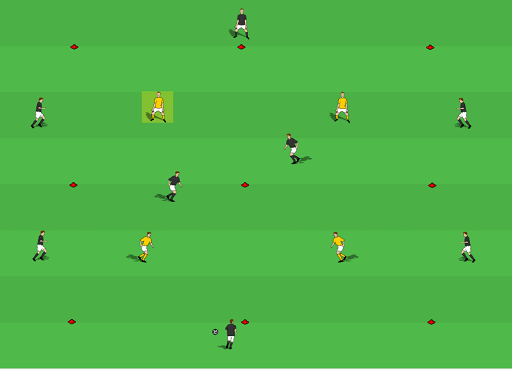
The position of the players mimics a 4-4-2 formation, minus one center back and one forward.
Black Team (Attackers): Maintain positions and possession of the ball with the emphasis on going forward from Centre Back to Forward (from the bottom of Diagram 1 to the top), rotating through the middle and utilizing passing options of support players, creating diamond and triangle shapes.
Diagram 2
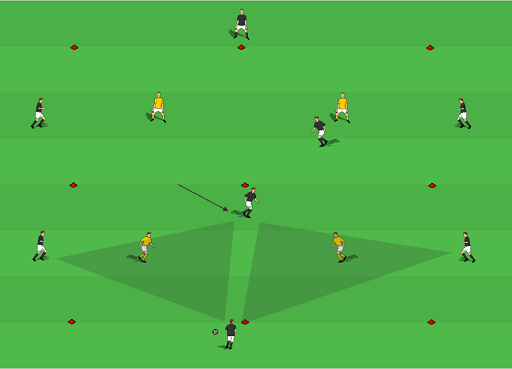
In diagram 2 above, one of the central midfielders drops into the hole between the two opposing forwards, creating two triangles of support for the ball. The outside players slide down off the shoulders of the defenders to give wide passing options,
Diagram 3
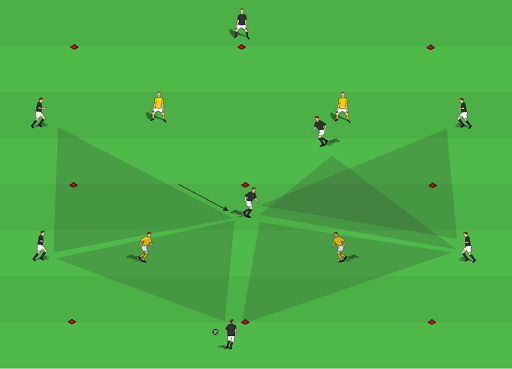
These players look to create passing options (triangles and diamonds) in wide areas to penetrate and advance forwards.
Diagram 4
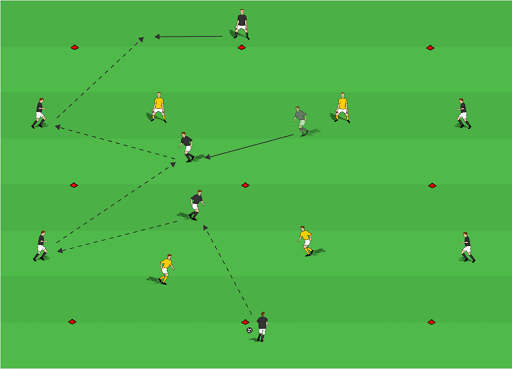
Yellow Team (Defenders): If possession is won, there are two options. Either play to the bottom player in black (center back) as quickly as possible, which replicates a counter attack in a game, or maintain possession 4 vs 2 in the central area (see below in Diagram 5. The center mids have to work hard in attack and then also work hard in defense to quickly win the ball back.
Diagram 5
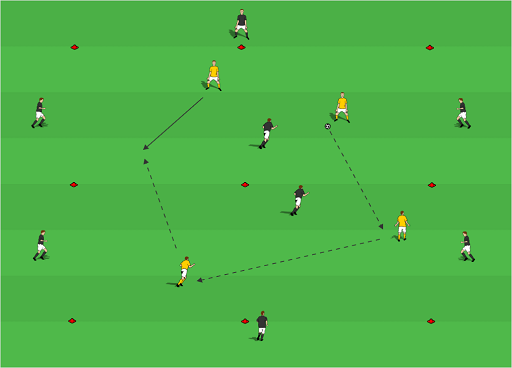
Competition: For the offense of 8, 10 passes is a point. If the defense steals the ball and manages to make 5 passes in the 4 v 2 in the middle, they score a point. Of course, you can adjust this number based on the age and skill level of your players.
Progression
When the attackers have success, add the condition that the defenders can move freely instead of staying in their rectangle.
Allow the wide “midfielder to go inside when the ball is in their half, also allowing the wide “fullbacks” to move up. Use rotation to create attacking overloads higher up the pitch, through overlapping and inverted runs.
Key Coaching Points
- Angles and distances between the wide players (simulating Full Backs and Wide Attackers) and Central Midfielders (game realistic)
- Quality, weight and decision of the pass (penetrate, play around or retain)
- Movement (Rotation) to receive and create diamond and triangle passing options
- Body shape to receive (taking the ball with the back foot)
- Angles, distances and combinations to penetrate effectively
- When to advance forwards and when to move inside
- Understanding slow and quick play through the areas
- Timing of passes
- Use the 3 passing lines (in front of defense, around defense & through defense) to create opportunities to penetrate
- Passing options around, behind and ahead of the ball
- Communication
By Gregg Gillies
Gregg Gillies is a nationally licensed coach through the USSF and is a Youth Athlete Development Specialist and Head Coach at Mount Laurel United Soccer Club, where he currently coaches a u14 girls team, the MLU Raptors. He also is the owner of www.NoLimitsSoccerTraining.com, where his focus is on maximizing a player’s individual technical skills, soccer IQ, and overall athletic development.
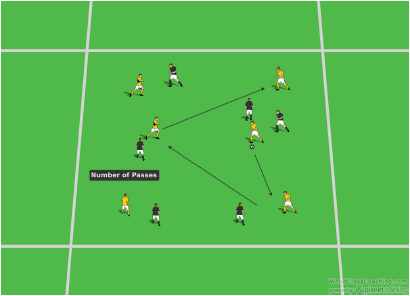
Switching Field of Play and Crossing Part One
By Gregg Gillies –
Set Up: Size (dependent on strength and skill of your players) at least 8-10 players plus GK (in the progression). 6 player set up, as seen in diagram 1 below. Have at least 8, with an extra player behind Player #1 and Player #4. If you have more than 8, you can put players behind any of the other spots. As seen in Diagram 1, you can use mannequins for the middle players to check away from and receive passes. You can also simply use corner flags or cones.
The Drill:
Players #1 and #4 each start with a ball. Players #5, 6 and 1 mirror players 2, 3, and 4 below. For the players to understand how this fits into a game, these can be either backs or midfielders. Player #1 plays to Player #2 (this is like a fullback playing to an outside midfielder if that helps your players visualize). Player #3 starts at the manniquin and checks back into open space to support Player #2 when the ball is received.
Player #3 opens up, let’s the bal roll across the body and takes the first touch with the left foot. Player #4 checks back to support and receive a pass from Player #3 (this pass should be with the right foot). The sequence starts again with Player #4 playing up the field to Player #5 the same way Player #1 passed to Player #2. Player #5 is in the Player #2 role and Player #6 is in the Player #3 role.
Depending on the skill level of your players, you may initially perform this drill with only one ball, starting at Player #1. Once they understand the drill and absorb the important details, such as checking into space, you can start with a ball at Player #4 and Player #1.
Each player follows their pass. Diagram 2 shows the completion of the passing sequence.
Diagram 1 (set up)

Diagram 2
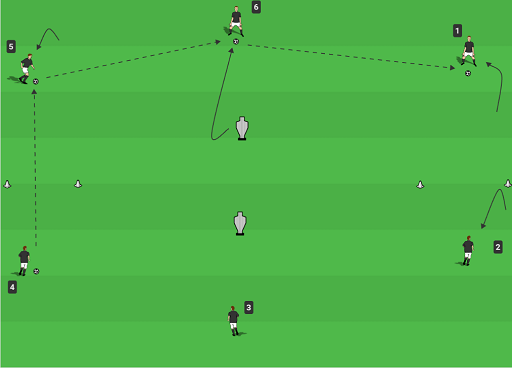
Diagram 3
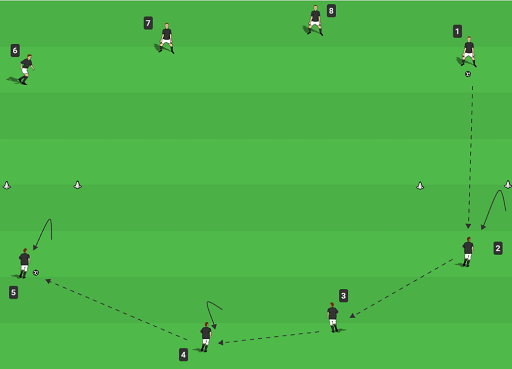
Progression: Diagram 3 and Diagram 4 adds a fourth player to the mix. Now you’re working with a backline or midfield that has four players. The drill continues in the same manner.
Diagram 4
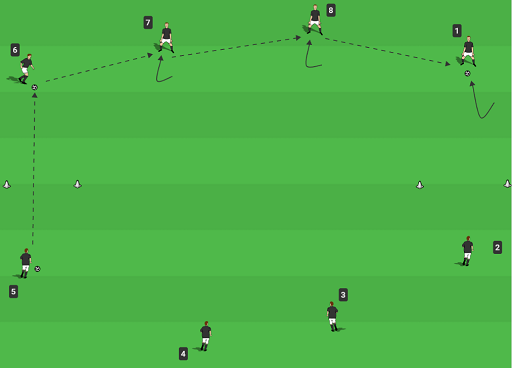
Coaching Points
The central player needs to start next to the manniquin (or cone) and drop into the support space to receive the pass facing forward. In the diagrams above, this would mean opening up and receiving with the left foot and then passing with the right foot.
When the central player takes that first touch, the outside player needs to drop back, open up their body and also take their first touch facing forward.
Make sure the players open up, receive with the proper foot and pass with the proper foot. In going left to right, the receiving touch should be with the left foot and the pass should be with the right foot.
The details are very important in a drill like this. The timing of the checks into space, the quality of the first touch, as well as the correct foot, the accuracy of the passes, as well as which foot makes the pass.
Opem up and receive with the back foot.
Progression/Variation
Switch direction of the drill. Now the first touch is with the right foot and the pass is with the left foot.
The next progressio is to make this drill more functional by going in one direction and adding crossing and finishing as well. There will also need to be a goalie.
Now the four players involved are facing a goal and they will switch the field from one side to the other before the outside player dribbles down the line and crosses the ball.
Diagram 5
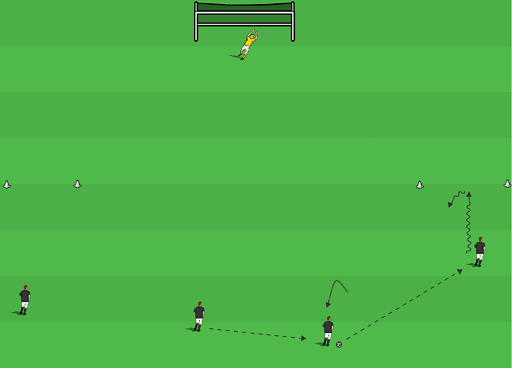
As you can see in Diagram 5 the ball goes across the field to the outside midfielder who dribbles forward, changes direction back, and plays a backwards pass to a supporting central midfielder. This midfielder plays the ball to the other central midfielder who completes the switch by playing out wide to the other outside midfielder.
This player dribbles foward to the corner and crosses the ball for a teammate to run onto.
Coaching Points
When the first outside mid dribbles forward (in diagram 5 this is the right outside midfielder), the other players move forward with him, just as in a game. When the outside mid makes his cut with the ball (as if protecting the ball from a defender), the inside midfielder needs to check back into a good support position to receive the pass.
Be sure and switch the direction so crosses come from both sides of the field.
As you can see in Diagram 6 below, the other midfielders all make specific runs. The two central midfielders cross each other with one going near post and the other going far post. The outside mid makes a late run for any cross that comes all the way through or over the central players.
Diagram 6
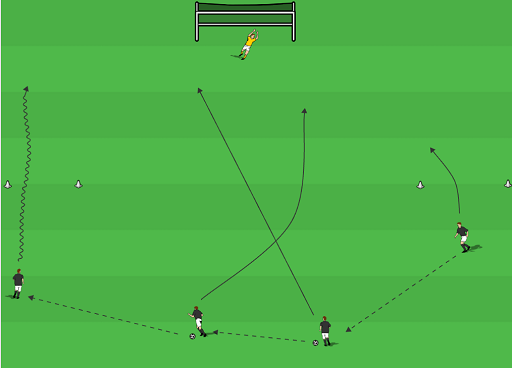
By Gregg Gillies
Gregg Gillies is a nationally licensed coach through the USSF and is a Youth Athlete Development Specialist and Head Coach at Mount Laurel United Soccer Club, where he currently coaches a u14 girls team, the MLU Raptors. He also is the owner of www.NoLimitsSoccerTraining.com, where his focus is on maximizing a player’s individual technical skills, soccer IQ, and overall athletic development.

3v2 to 4v3 Transition to Goal
By Gregg Gillies –
Set Up: Size (45 x 35 depending on age, skill level, etc. – can be brought down as far as 30 x 25) Depending on your technical and tactical focus as well as equipment available this can be played with small goals or full size with goalies.
See diagram 1 below for the set up of each “team.” Each team goes for either a set number of rounds, like 10, or a set time period, like 6 minutes before switching. Keep score and give the losers something to do.
The black team has three lines, one on each side of the goal and one out wide. The yellow team has a line on each side of their goal, and two players out wide at midfield.
Diagram 1
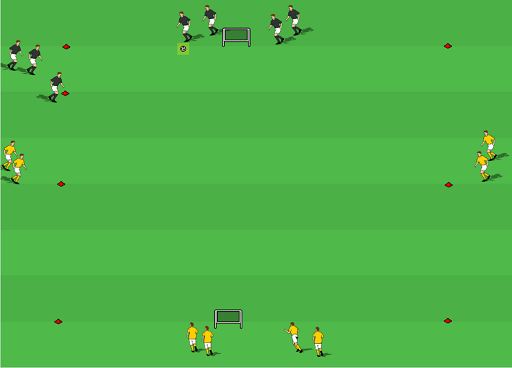
The Drill: As seen in diagram 2 (below), player 1 (in black) passes to player 2. Player 2 dribbles inside while player 1 overlaps player 2. Player 3 runs into the field of play while players 5 and 6 (defenders in yellow) come out to defend.
After the initial pass and overlap, it proceeds as a normal 3v2 to goal.
If a goal is scored or the ball goes out of bounds, the attack is over. The black players rotate amongst their three lines. The yellow players rotate amongst their four lines.
If the defenders win the ball (or the goalie makes a save if you are playing with goalies), yellow can immediately counter by playing wide to player 4 or player 7 in a 4v3 counterattack.
All lines for both teams should rotate after each round, even if yellow doesn’t win the ball and counter. So even though players 4 and 7 may not be involved in a round .they should still move to the next line. If they don’t they could get stuck doing nothing for awhile if the defense doesn’t win the ball often. Keep the players moving and playing!
Diagram 2
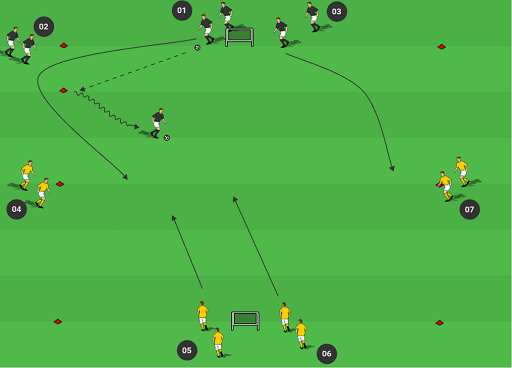
Diagram’s 3 and 4 are the continuation of a successful attack by the black team.
In diagram 3, the wide player continues to dribble into the middle of the field and plays wide to player 3. After the overplap, player 1 continues a diagonal run across the field, giving player 2 an option to play a pass down the line. Diagram 4 shows the finish.
Diagram 3
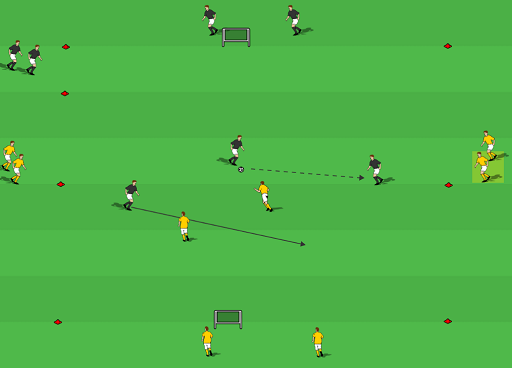
Diagram 4
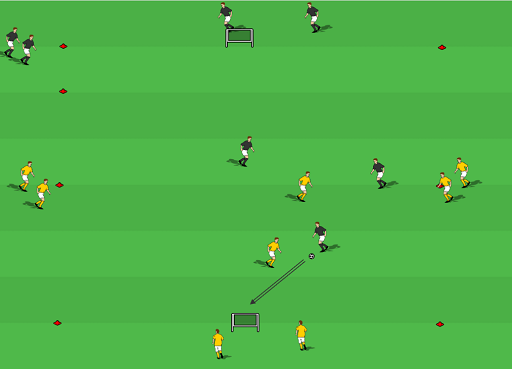
In diagram 5, you see the transition to the 4v3. A yellow defender intercepts a pass and passes out wide, bringing the wide player on the other side into the game as well. Black now needs to quickly get organized and transition back behind the ball to stop the 4v3 counterattack.
Diagram 5
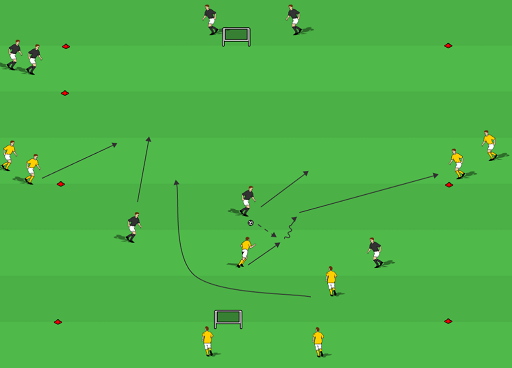
Coaching Points:
• Taking advantage of numbers up with speed of play via quick passing and runs off the ball.
• Counterattacking ability
• Timing of runs
• Variety of runs. It shouldn’t always be vertical runs up the field. This is why the drill starts with a mandatory dribble in to the center from wide and an overlap.
• Challenging players 1v1. Numbers up in a 3v2 should give players space and opportunity to challenge 1v1.
• Good decision making
• Defending numbers down
• Quickly getting organized and back as a defense when you lose the ball in the 3v2
• Closing people down
• Cutting off angles
• Communication
• Timing, vision, awareness, anticipation, speed of play and accuracy and weight of the pass are extremely important.
Progressions / Variations
Depending on your focus, as well as the team’s skill level and age, you can regress this drill and make it a 2v1 with a 3v2 transition. Just eliminate one of the two lines (one per team) next to the goals. For less experienced, skilled or younger teams, this can make things easier by reducing the number of options available so they aren’t overwhelmed by the decision making process.
To encourage speed of play and make it more difficult, set a time limit for the attacking team such a 6 or 10 seconds.
Another progresion is to make all finishes one touch.
If you want to encourage 1v1 play, then maybe a player needs at least three touches before shooting.
Many younger players struggle with varying their runs and have a tendancy to go straight up and down the field. Starting with an overlap and a wide player dribbling inside is designed to teach other options. By doing so at the beginning of a competitive drill, you can get technical and tactical work unopposed but at game speed.
You can start the drill with any number of different pass and run combinations. Maybe player 1 plays a lateral ball to player 3 while player 2 makes a diagonal run to receive from 3 while player 1 overplaps player 2.
Maybe player 1 just plays a quick give and go with player 2. This is a good way to use patterns of play within a game, at game speed but without real defensive pressure.
A bigger field will give them more room to be successful and will also double as a conditioning game. If you make the field narrower, quick, accurate combination play becomes more important.
By Gregg Gillies
Gregg Gillies is a nationally licensed coach through the USSF and is a Youth Athlete Development Specialist and Head Coach at Mount Laurel United Soccer Club, where he currently coaches a u14 girls team, the MLU Raptors. He also is the owner of www.NoLimitsSoccerTraining.com, where his focus is on maximizing a player’s individual technical skills, soccer IQ, and overall athletic development.
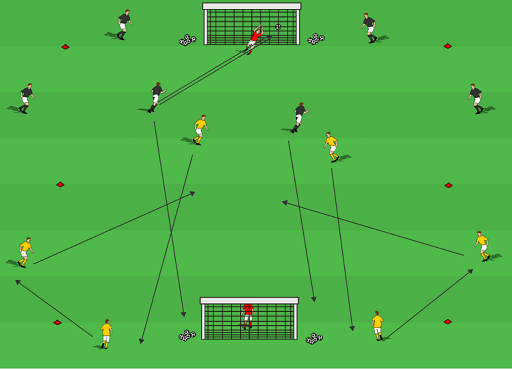
Attacking Play and Finishing Around The Box
By Gregg Gillies –
Set Up: Size (25 x 20 yards) at least 12 players plus 2 GK
The Drill: Two teams (black and yellow). Each team has 2 players on the field of play. Each team also has two players on the outside of the cones, on the offensive half only.
Both teams have two players on the endline, one on each side of the goal. These players are in the offensive half. In other words, as seen in diagram 1 below, the team in black is shooting on the goal that has their teammates standing next to the goal. Yellow is shooting on the goal with the the yellow players on the endline.
Play 2 v 2 in the middle with each team having 4 outside players they can pass to. Only the 2 players in the middle can score. Offensively speaking, the drill uses 6 attacking players similar to the front 6 of a 4-4-2 with the 2 in the middle being the central midfielders. The two out wide are the outside midfielders.
The two on the endline are like back to goal forwards. While having them on the endline is somewhat unrealistic the positives out way the negatives as there are a lot more scoring opportunities with them there. To help the players understand it visually, think of them as players who got endline and are playing cut back crosses.
Limit the outside players to one or two touches. With two touches the ball can’t stop moving. If they are skilled enough make it one touch.
Outside players can play to outside players.
Make sure there are a number of balls in each goal.
Winners stay on. Losers rotate. The 2 players on the field go to the endline. The two endline players rotate to the wide positions and the wide players move on to the field and play. See diagram 3 below.
The winners race back and grab a ball out of their own net and begin play. They do NOT wait for the yellow team to get organized.
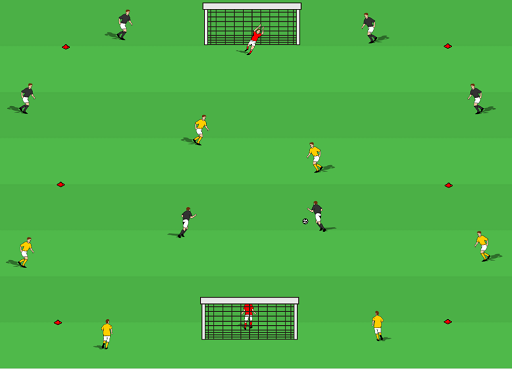
This is a high tempo, competitive attacking game. As the players get used to the game, there should be a lot of shots and goals. In order to keep things moving, consider a time limit. If neither team scores in a minute, or 90 seconds or two minutes, make both teams rotate. Call out which team gets the ball.
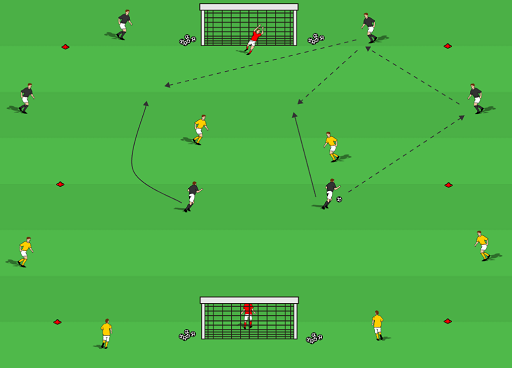
Here is an example of combination play using the outside players.
Diagram 3 (This is the rotation example with the black team scoring)

The two players in black go back to get a ball out of their goal. For yellow, the players in the middle go to the endline. The endline players go out wide and the wide players come inside to defend.
Coaching Points
Finding shooting angles. Except for the younger age groups, almost anywhere on the field of play is a shooting opportunity, with only 25 yards from goal to goal. They don’t need to dribble by a player, they just need to use a fake or feint to create a shooting angle around the defender.
Making runs. The two players in the middle should never be standing still.
Variety of runs. It shouldn’t always be vertical runs up the field. The two players in the middle shouldn’t always be on one side of the field.
Using the outside players. Players, especially younger ones, have a tendency to ignore outside players or neutral offensive players, which negates the entire reason for having them. Encourage the 2 in the middle to use the outside players to help them create more chances.
High tempo
Communication
Quick combination play
Vision, awareness and anticipation. If players don’t get their heads up and think ahead, they will not be able to work together to create scoring opportunities. With the one touch restriction outside players must be anticipating and thinking ahead at all times.
Progression/Variation
Limit the outside players to one touch.
Have the outside players only play crosses instead of looking to make passes to feet. To facilitate an emphasis on crosses, maybe widen the field 5 yards on each side.
Progress to 4v4 in the middle. Increase the length of the field from goal to goal to a double box, 36 yards.
As the players get used to the drill and the rotation, this will become a high tempo attacking exercise with a lot of shooting and finishing for the players without them standing around in lines waiting for their turn.
By Gregg Gillies
Gregg Gillies is a nationally licensed coach through the USSF and is a Youth Athlete Development Specialist and Head Coach at Mount Laurel United Soccer Club, where he currently coaches a u14 girls team, the MLU Raptors. He also is the owner of www.NoLimitsSoccerTraining.com, where his focus is on maximizing a player’s individual technical skills, soccer IQ, and overall athletic development.
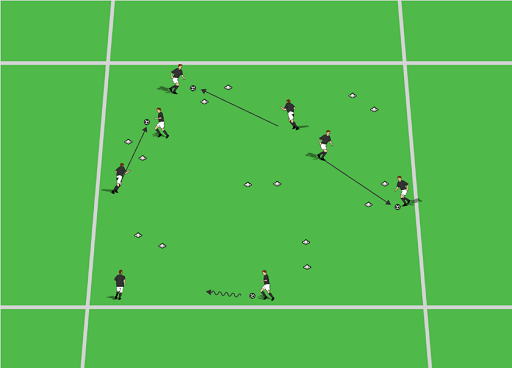
Competitive Technical Passing
By Gregg Gillies –
Warm Up
Set Up: Space can vary depending on number of players and how difficult you want it to be. Set up a variety of cone “goals” randomly throughout a space and pair up your players in teams of two, each team has one ball. Use at least 5 cone “goals.”
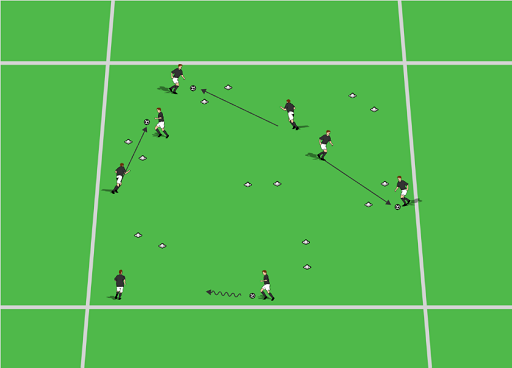
The players, in pairs with one ball, are to complete as many passes as they possibly can through the cone goals scattered thoughout the playing area, in a set amount of time (30 to 90 seconds). The team with the highest number of completed passes wins.
Players can not complete multiple passes through the same goal without going to at least two other goals first.
You can vary the number of goals and size of the playing area to make the drills more or less difficult. The smaller the area, the more traffic that each team needs to be aware of and avoid, making the game more challenging.
Make the receiving player of a pass that scores a goal call out the number of that goal, loud and proud. This helps with getting players to talk, especially at younger ages.
Coaching Points:
The accuracy and pace of the pass, as well as good communication between players on a team are extremely important in being successful at this drill.
Players need to keep their heads up and be aware of their surroundings so they don’t run into other players or have a pass fail because it hit another player or another teams ball.
The quality of all touches is important so traffic can be avoided, causing time to be lost if a ball is knocked away via a collision with another player or another ball.
Progressions and Variations
Set Up: See below in diagram two. Divide up into multiple teams of four to six players. The cones that need to be passed through and the distance between the cones will depend on the skill level of your players. 10 to 12 yard passes are long enough distance wise as we are looking for quick, quality passes on the ground with at most two touches, one if possible.
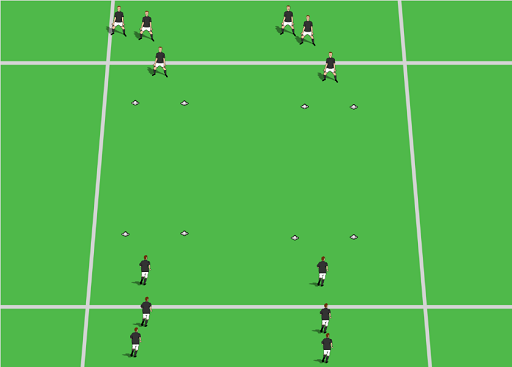
Passes must go between the two cones in front of the player you are passing to. That player can then play a one touch pass or take a first touch. The return pass must also go through the far two cones. When a pass is made, that player goes to the back of the next line.
The teams are competing to complete the most number of passes in a set time like 30 or 45 seconds. Any pass that does not go through the far two cones, does not count. This is true if the pass goes wide, but also true of the receiving player steps up and takes their first touch ahead of the cones without letting the ball travel through.
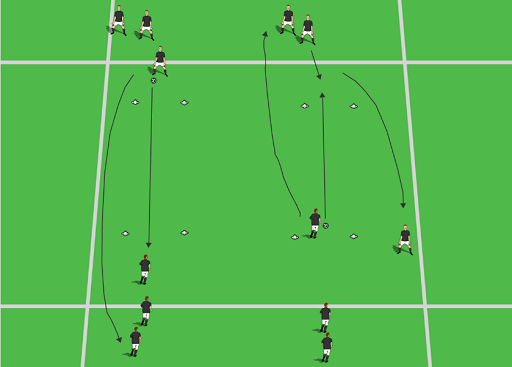
Coaching Points
Focus on accuracy and weight of the pass. A good, solid pass that allows a teammate to return it with one touch will give a team the ability to complete more passes in the time allowed. The more touches a teammate must take to control the pass, the fewer total passes that will be completed.
Whichever team completes the most number of passes wins.
The competition and cones takes a simple, boring passing drill and dramatically increases the intensity and focus of the players.
Progression/Variation #2
Same Set up but add a 1-2 into the senquence as shown below in diagrams 4 and 5.
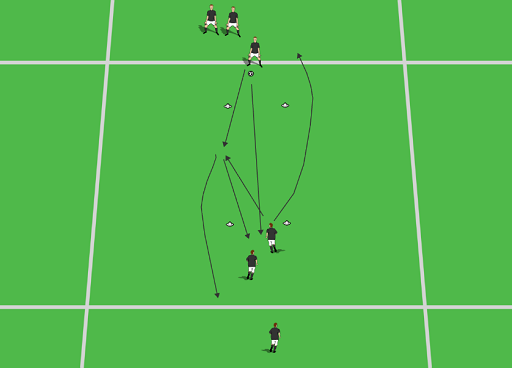
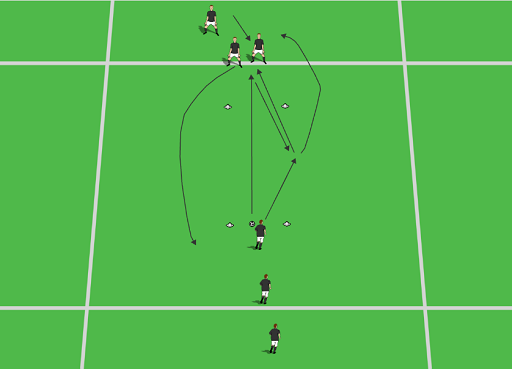
In this version, count all passes completed that go through the cones.
These drills and variations are a great way to work on technique without defense but also add an ellement of pressure and intensity (as well as focus) that you don’t get with typical drills. Adding that element of competition can help players more quickly develop their technique and skill.
One last thought on the competition element. You can create two (or three or more depending on total number of players) to make it one overall competition by adding the total number of passes completed through each variaton.
For example, let’s say you have 12 players and in the team passing drill, you have 3 reams, which is 4 players per team. For the first drill, when they are working in pairs, separate them into 3 teams of 4 players and then into pairs within each team.
The total number of completed passes is the total of the passes completed by the pairs within each team. Then keep the same teams throughout all variations, with the winner being total number of passes completed throughoug the session.
By Gregg Gillies
Gregg Gillies is a nationally licensed coach through the USSF and is a Youth Athlete Development Specialist and Head Coach at Mount Laurel United Soccer Club, where he currently coaches a u14 girls team, the MLU Raptors. He also is the owner of www.NoLimitsSoccerTraining.com, where his focus is on maximizing a player’s individual technical skills, soccer IQ, and overall athletic development.

Show and Go-Go and Show
By Gregg Gillies –
Players, especially at a younger age, struggle with the concept of specific off the ball movements in order to create space from a defender and get open to receive a pass. In this drill we are going to work on creating space using the specific techniques of ‘show to go’ and ‘go to show’, also known as ‘check away and to’ and ‘check to and away.’
Set Up: (20 yds x 10 yds) 3 players per group as shown below in diagram 1. Include a cone square in the middle with the cones roughly 4 yards apart.
There is a player at each end and one in the middle, standing next to one of the four cones. We are working on two specific movements – going away from the ball and showing back to it as well as showing to the ball and then going away into space.
Diagram 1
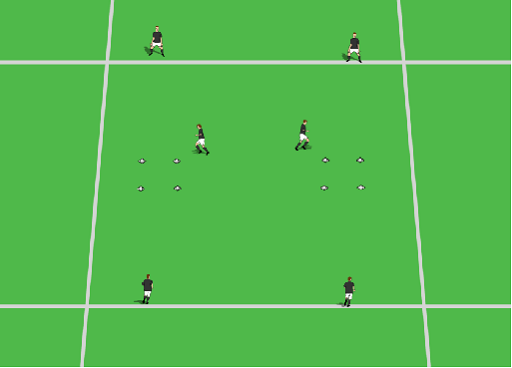
Above is the starting position of the drill. It shows two groups. The first group on the left will go through the show to go movement and the second will show the go to show movement. This can be seen below in Diagram 2.
Diagram 2
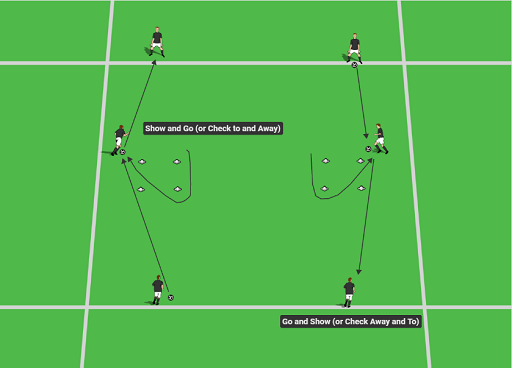
On the left, the player moves parallel to the two cones, toward the player with the ball and then bends the run diagonally away to create space from the defender, in order to receive a longer pass.
On the right, the player is starting closer to the player with the ball, starts the run away, and then bends back diagonally, sprinting into space in a support position to receive the pass, preferably in a side on position to be able to see the field. To do this the player must sell the “go” run in order to create enough space from the defender to receive the ball in this position, with the outside, or back, foot.
Once they receive the ball, they pass it to the third player on the other endline.
When initialy learning these movements with younger players, you can teach them one and reset after each play through.
Once they know the two movements, as you can see above, after passing the ball to the third player, they are in position to make the opposite run. If they started with a ‘show to go’ they are now in the starting position of the ‘go to show.’
When they know both, the drill can continue nonstop with the same player in the middle. You can rotate the middle player ever 60 to 120 seconds.
Coaching Points
The player needs to be decisive with their movement so that the defender sees it and stays with them on the initial run. Then the player turns quickly, changing the run and leaving the defender behind as they move into space to receive the pass.
The player needs to sell the initial movement to draw the defender before moving into space.
Timing – stress the importance of the timing, both of the run and the pass, so that the pass is received in space at the appropriate time.
Body Positioning – the player should check their shoulder on the “go to show” movement to be sure they can get in a side on position to receive the pass. While it’s not always possible in the game, be sure they put in the extra effort on the run to always get side on in this drill with no defense.
By getting side on and taking the ball with the back foot they are able to see the entire field as they receive the ball, giving them more time to make a decision.
In the ‘show to go’ movement, when successfully employed, the body positioning is completely different. In ‘show to go’, you are hoping for a slightly longer pass that can be played ahead of the player, into space for them to run on to, preferably to the outside of the now trailing defender, keeping the offensive player’s body between the ball and the defender.
Creating Space – The most important thing to know is where is the defender. This, along with the timing, weight and accuracy of the pass, will determine how a player is able to receive the ball. How do we do this? The player making the run must check their shoulder so they know if they’ve created enough space between them and the defender to open up and receive the ball in a side on position.
Decision Making – the player receiving the pass needs to make the correct decision on how best to receive the pass in order to keep possession.
Technique – a good decision needs to be followed by a quality first touch that allows the player to keep the ball and be able to make a decision to dribble or pass.
Progressions
In the first progression, as seen in Diagram 3 below, is quite simple. Remove the four cones making a square and replace with one cone, or pole to simulate the defender. Now the players need to make the same runs without the extra guidance of the four cones showing them exactly where to start the run and change direction.
With older more experienced players, you may start here (or even with the second progression in diagrams 4 and 5).
Diagram 3
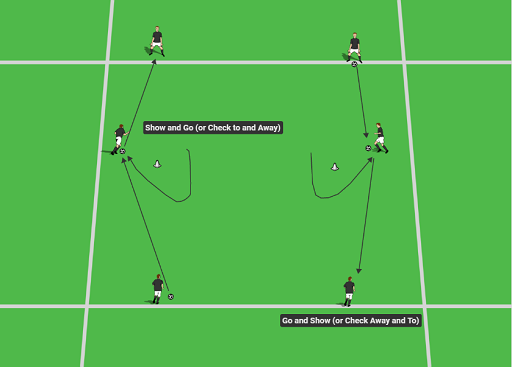
The next progression is seen in Diagrams 4 and 5. This uses a passive defender.
Diagram 4 (Go to Show)
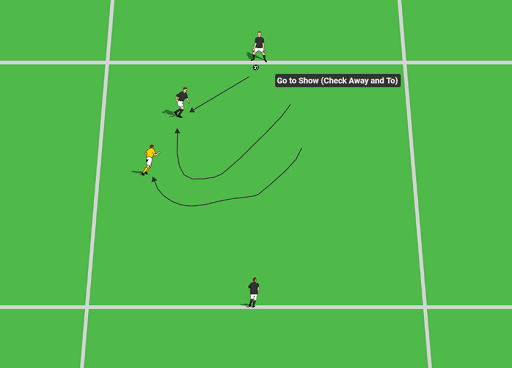
Diagram 5 (Show to Go)
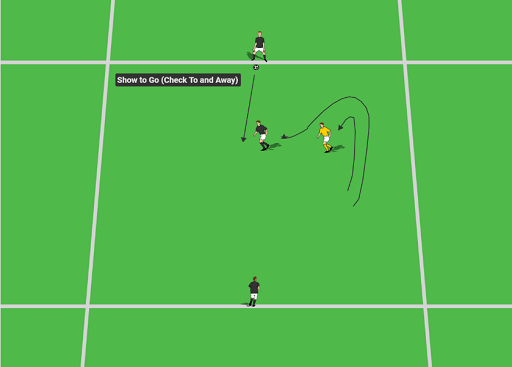
Once the players are doing well with this, you can have the defenders vary their response to the run. Sometimes let enough space be created (especially in Go to Show) so that the player receiving the pass can get side on. Sometimes have the defender not be fooled (but allow the player to receive the pass) and trail the offensive player but in a closer position so getting side on to receive would be difficult.
This will help get the player used to checking their shoulder and making decisions on how best to receive the pass.
Finally, you can have the defender go 100%. The offensive player’s goal in the middle is to receive a pass using these techniques and make a pass to the player on the other endline. Always restart with the offensive and defensive players in the middle.
The choice of which run to make is up to the offensive player. The defender knows it’s one of two runs, but not which one.
Movement off the ball, especially specific runs and techniques are not natural for younger players. They watch the ball. Including these two simple runs can help with that.
By Gregg Gillies
Gregg Gillies is a nationally licensed coach through the USSF and is a Youth Athlete Development Specialist and Head Coach at Mount Laurel United Soccer Club, where he currently coaches a u14 girls team, the MLU Raptors. He also is the owner of www.NoLimitsSoccerTraining.com, where his focus is on maximizing a player’s individual technical skills, soccer IQ, and overall athletic development.
